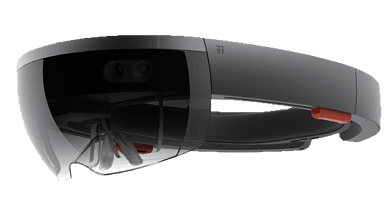Bite-sized news, views and updates from the global tech industry, by Anne Whelton.
Is 10 the magic number?
The launch of Windows 10 last month signaled, what Microsoft CEO Satya Nadella called “the beginning of a more personal computing era in the mobile-first, cloud-first world”.
A number of new features were revealed during the unveiling of the next generation of Windows, including the final nail in the coffin for Internet Explorer. Window’s new browser, Project Spartan, will include the ability to annotate directly onto webpages, a more simplified layout, and integration of Cortana – Microsoft’s personal digital assistant, which debuted on Windows Phone last year – for faster and more efficient browsing.

With this in mind, Microsoft has developed ‘HoloLens’ – the world’s first untethered holographic computer which the tech giant claims will allow users to see and hear high definition holograms in the world around them.
The future is holographic
- SpecsHoloLens have no cords or wires;
- Offer transparent lens and advanced sensors;
- Are lightweight and adjustable;
- Have built-in spatial sound;
- And next-generation technology enabled by Windows 10.

Nothing mini about these minds!
On Friday January 23rd at the Science Gallery, Dublin, students from around Ireland took part in the Intel Mini Scientist Grand Final.
Now in its eight year, the event offers primary school students the opportunity to explore science through project-based learning and exhibitions.
This year, the winning project – entitled ‘What Lurks Within’ – was completed by 4th class students at Timahoe National School in Co. Laois, Jamie Boyle and Róisín Dunne, are involved in an investigation to discover if there are dangerous bacteria contained within a mascara tube and how such bacteria can affect a user’s eye. The future of STEM is safe with these little scientists!
Tech trends
Our friends at Wareable.com gave us this insight into the trends expected in 2015:
According to a Forrester Research report presented in Paris in December 2014, the wearable tech market looks set to triple in 2015.
More than 20,000 businesses and people across the US and Europe were polled earlier in 2014 and the results found that Americans are more accepting of the latest tech revolution, with 45% of respondents indicating that they would be willing to strap a connected device onto their wrist, compared to 32% of Europeans.
The report also states that 10 million Apple Watch units will be sold in 2015 – much less than the forecasts the Wareable team have previously seen. In November we heard from Morgan Stanley that up to 30 million Apple Watch units could be shifted in 2015, and in December UBS estimated that 24 million would be sold.
Despite the difference in opinion in sales of the Apple Watch, the launch in April will help 2015 be the year that smartwatches go mainstream.
At CES this year, we saw launch prices of wearable tech lowered in every category. This, along with the fact that brands are building wearable devices that are smaller and better looking, longer lasting, more compatible and upgradeable, will further boost sales of fitness trackers, smartwatches and other wearable tech in 2015.
Boom boom BOOM
The always-reliable Ultimate Ears recently added the UE MEGABOOM to its range of next-generation portable wireless speakers.
Similar to the UE BOOM – but bigger and louder – the MEGABOOM offers 360-degree sound and 20+ hours of rechargeable battery life in a waterproof/stain resistant skin for easy transport. For many, it is also seen as the only contender for the Jawbone’s crown when it comes to Bluetooth speakers. From US$300 on ultimateears.com.
Safety in numbers
We were pleasantly surprised when we put the drive to the test and even locked ourselves out at one stage! Available from istorage-uk.com starting from €38 for an 8GB.
Three strikes law
The top three trends in 2014, as identified by Cisco are: Snowshoe spam, which involves sending low volumes of spam from a number of IP addresses to avoid detection; Web exploits hiding in plain sight, when attackers use less common kits so as not to attract attention; and Malicious combinations, which involves uniting the historically insecure Flash and JavaScript. Sharing exploits over two different files can make it more difficult for security devices to identify and block the exploit.

